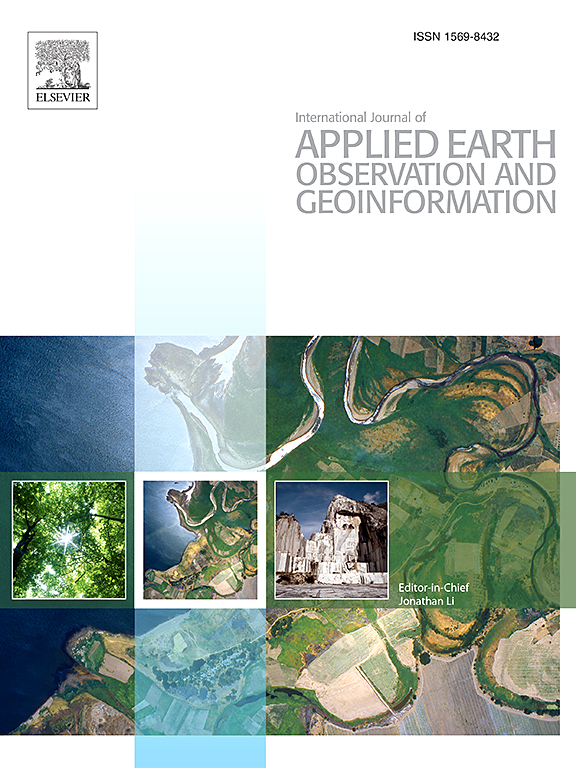基于门控自适应多尺度空频融合网络的灾后建筑损伤评估
IF 8.6
Q1 REMOTE SENSING
International journal of applied earth observation and geoinformation : ITC journal
Pub Date : 2025-05-28
DOI:10.1016/j.jag.2025.104629
引用次数: 0
摘要
准确的建筑损伤评估对于灾后响应至关重要,然而现有的方法难以捕捉复杂的空间关系和环境特征,以区分损伤水平。为了解决这个问题,我们提出了门控自适应多尺度空间频率融合网络(GAMSF),这是一个用于建筑物定位和损伤分类的两阶段框架。GAMSF集成了三个关键创新:(1)自适应注意(AA)动态优先考虑关键区域;(2)门控多尺度前馈网络(GMFFN)通过强调突出的损伤特征来增强鲁棒性;(3)多尺度小波融合(MWF)利用小波变换提取细粒度结构细节。对数据集(包括xBD和xFBD)的严格评估表明,与现有方法相比,GAMSF达到了最先进的性能,f1得分提高了1.7%,Kappa提高了2.1%,轻微损伤识别精度提高了3.7%。此外,在高分辨率Ida-BD数据集上的可转移性实验验证了GAMSF优越的泛化能力,优于四种先进的模型。这些结果突出了GAMSF在加强灾害管理、应急响应和资源分配战略方面的实用价值。本文章由计算机程序翻译,如有差异,请以英文原文为准。
Post-disaster building damage assessment based on gated adaptive multi-scale spatial-frequency fusion network
Accurate building damage assessment is crucial for post-disaster response, yet existing methods struggle to capture complex spatial relationships and contextual features needed for distinguishing damage levels. To address this, we propose the Gated Adaptive Multi-scale Spatial-frequency Fusion Network (GAMSF), a two-phase framework for building localization and damage classification. GAMSF integrates three key innovations: (1) Adaptive Attention (AA) to dynamically prioritize critical regions, (2) Gated Multi-scale Feed-Forward Network (GMFFN) to enhance robustness by emphasizing prominent damage features, and (3) Multi-Scale Wavelet Fusion (MWF) to extract fine-grained structural details using wavelet transforms. Rigorous evaluations on the datasets, including xBD and xFBD, demonstrates that GAMSF achieves the state-of-the-art performance, with a 1.7% improvement in F1-score, a 2.1% gain in Kappa, and a 3.7% increase in minor damage identification accuracy compared to existing approaches. Furthermore, transferability experiments on the high-resolution Ida-BD dataset validate GAMSF’s superior generalization capabilities, outperforming four advanced models. These results highlight the practical value of GAMSF in enhancing disaster management, emergency response, and resource allocation strategies.
求助全文
通过发布文献求助,成功后即可免费获取论文全文。
去求助
来源期刊

International journal of applied earth observation and geoinformation : ITC journal
Global and Planetary Change, Management, Monitoring, Policy and Law, Earth-Surface Processes, Computers in Earth Sciences
CiteScore
12.00
自引率
0.00%
发文量
0
审稿时长
77 days
期刊介绍:
The International Journal of Applied Earth Observation and Geoinformation publishes original papers that utilize earth observation data for natural resource and environmental inventory and management. These data primarily originate from remote sensing platforms, including satellites and aircraft, supplemented by surface and subsurface measurements. Addressing natural resources such as forests, agricultural land, soils, and water, as well as environmental concerns like biodiversity, land degradation, and hazards, the journal explores conceptual and data-driven approaches. It covers geoinformation themes like capturing, databasing, visualization, interpretation, data quality, and spatial uncertainty.
 求助内容:
求助内容: 应助结果提醒方式:
应助结果提醒方式:


